What are the main benefits of tankless water heaters versus a tank and which is the better choice?
There really is no definitive answer to this question as it depends on the situation. Below we will discuss the differences, pros, and cons between the two based on my experience and knowledge as an 18 year licensed plumber working in Texas and Montana. At the end, you will be able to make an informed decision for your household.
Tankless water heaters are not a new technology for heating water, and there are plenty of articles that go further into the history of storage tank-type water heaters and tankless water heaters. That is not the purpose of this article as we are only going to discuss the modern ones.
Questions about tankless heaters and their benefits are common questions we get. There is a lot to discuss in order to come up with what will work best for each situation. First, when presented with the question of a customer wanting a tankless water heater, we always ask, “What benefits are you trying to gain from converting to tankless and how familiar are you with the system?” This will help to establish the course of the conversation. The reason we ask this is to determine if this is a good option and if the customer understands the features and benefits of a tankless.
The Basics of Traditional Water Heaters
Let’s first go over the basics of a storage tank water heater. The technology is fairly basic as far as the standard 50 gallon electric or gas storage tank type water heater for residential and commercial applications. It consists of a water tank with a heating source, either gas or electric, and a cold water inlet and hot water outlet. Both gas and electric water heaters do the same thing: heat a tank of water to a set temperature with an energy source to do just that. The tank has a thermostat that reads the water temperature. On a gas water heater, the thermostat is a probe that is submerged in the tank at the bottom and has an adjustable temperature dial on the front. The reason it is located at the bottom of the tank is because that is where the water temperature is the coolest. When that water temperature reaches below the set level on the thermostat, it calls for the burner to start heating the water. On an electric water heater there are two thermostats, one on the top half and one on the bottom half. They read the temperature at the top and bottom of the tank. Once the temperature is reached, the heat source turns off. All tank-style water heaters are wrapped in insulation and that insulation is enclosed within a thin metal jacket. Basically, the outside of a tank water heater is not the actual storage tank but rather a jacket to encapsulate the insulation around the storage tank. Because of the insulation, the water inside the tank can stay hot for up to 6-8 hours, if no hot water is used during that time. Even if no hot water is being used, energy is periodically being used in order to keep it hot. The same is true for electric water heaters except they use a heating element to heat the water. On an electric water heater, the thermostats read the temperature of the tank wall as opposed to a submerged probe type on gas water heaters. These two methods for heating water heater tanks have been in use for over 100 years and both are tried and true.
There are many benefits to having a tank style water heater so let’s look at a few. One benefit of a tank style is they are simple and require very little maintenance. The main type of maintenance for a tank water heater is to flush it at least once a year. This helps to keep from mineral deposits building up and causing the tank to lose efficiency. That, along with replacing the temperature and pressure relief valve every couple years, is all the maintenance generally needed for a tank type water heater, save for occasional visual inspections to see if leaks or corrosion are present. On average, most tanks last about 8-12 years before needing replacement, depending on water quality and a few other factors. Another benefit of having a tank type is replacement parts are typically inexpensive and readily available. Most of the time they work without issue for many years and are fairly inexpensive to maintain. If there is a power outage with an atmospherically-vented gas tank water heater (the most common in this part of Texas), you will not lose hot water as opposed to a gas tankless water heater which does require a small amount of electricity in order to function. The cost to replace a tank style is also less than converting to tankless or replacing an existing tankless. Suffice it to say, a storage tank style is simple.
What are the disadvantages of storage tank water heaters?
A 50 gallon tank water heater, when full, weighs approximately 550 to 600 lbs. Many of these are located in the attic in this part of the country or above a restroom in a commercial application. So, the thought of a tank full of water sitting overhead can be daunting. There are a few reasons why tank style water heaters are located in the attic or in the ceiling but, in my opinion, none are good enough to justify it. Be that as it may, having a 600lb tank full of scalding hot water sitting in an attic is a potential disaster waiting to happen. Add that to the fact that most people only go into their attic twice a year – once to get the holiday decorations and once to put them back, this is not an ideal situation. In other words, people in homes with attic-located water heaters rarely ever think about their water heater until it stops working or has a leak. Even though our plumbing codes require an emergency drain pan to be installed below a tank or tankless water heater, a leak can still make its way outside the pan and cause damage to the ceiling below. We can install a Flood Stop Safety valve to mitigate this issue as seen in the photos below. There are plenty of photos on the internet that one can look up that show tank style heaters that have ruptured or slowly leaked for years, causing a lot of damage, especially when located in the attic. This issue is one of the main reasons that justify converting to a tankless water heater. Tanks are also bulky and take up a lot of room and require some sort of structure around them to protect them from the elements. Another issue is that a tank style can simply not keep up with very heavy demand. During times when guests are staying or in the winter when typically more hot water is used, a tank type water heater can fall short with demand. One thing to consider is many homes today have master bathrooms with a garden tub and shower. The typical garden tub can hold between 80 to 100 gallons. Many of these homes have one 50 gallon water heater serving the bathrooms. If the tub is filled, it will diminish most of the tank’s capacity, if not all of it, depending on the mixture of hot to cold water. That translates to having to wait up to 45 minutes to completely reheat the tank of water. This can be an inconvenience and one that a tankless can remedy. If an addition to a home or business is planned, usually that includes adding a bathroom or adding fixtures which means more hot water will be needed. Oftentimes, the original water heater will not be large enough to keep up with the added fixtures.
So, what about tankless water heater pros and cons?
Note: We do not install whole house ELECTRIC tankless water heaters for a few reasons. One reason being electric tankless units almost always require an overhaul of the property’s electrical system due to requiring three – 60 amp dedicated breakers and can typically only provide about five to six gallons per minute of hot water versus a gas tankless which can provide up to eleven gallons per minute of hot water or more. There are better options for gaining energy efficiency for electric water heaters with electric hybrid water heaters that we will go into later.
A basic explanation of how a tankless water heater works: A hot water tap is turned on at the point of use such as a kitchen sink or shower. As water begins to flow through the tankless unit, it passes through a stainless steel or copper heat exchanger that has a heat source to heat the water as it flows. As the water passes through the heat exchanger and reaches the set temperature, it then flows out of the unit at that set temperature and from there to the point of use. This process begins when a hot water tap is turned on due to the unit having a sensor that detects flow which in turn tells the unit to begin to heat. There is no holding tank that gets heated on most tankless units. The water gets heated as it flows through the heat exchanger and is controlled by flow restrictors in order to make sure the water reaches the temperature set at the thermostat prior to flowing out.
Let’s first look at the advantages of tankless water heaters.
How does a Tankless Water Heater Work?
A tankless water heater does provide “on-demand” hot water but that can be misleading. It does not provide that hot water instantly at the point of use but instead at the actual tankless unit. When a hot water tap is turned on, the unit will fire up and start heating the water as it passes through the heat exchanger. That is the on-demand aspect of a tankless water heater. So, on-demand simply means heating the water when there is demand. The two main benefits of this type are energy efficiency and a never-ending source of hot water. A storage tank style water heater uses a pilot light to ignite the burner when it calls to reheat the water and is always keeping a storage tank full of water hot. On a tankless, however, there is no pilot light. This, along with only heating the water that is used, makes them more efficient by not needing to keep a tank of water hot or having a small pilot light lit 24/7.
For comparison, the energy efficiency factor of a standard gas-fueled storage tank water heater is .67. This means that of the total energy used to heat the water, only 67% is actually used for heating and 33% goes out the exhaust vent. A tankless water heater, depending on the model and type, has an efficiency factor between .80 to .94. As you can see, the efficiency is much better with a tankless. There are different types of tankless water heaters available which is why there is a range of 80 to 94% efficiency. Another way to look at energy efficiency is that for every dollar spent on energy for a tankless that is 80% efficient, 80 cents goes towards actually heating and 20 cents goes out the exhaust. That is much better than a tank type where 33 cents of every energy dollar goes out the exhaust vent.
There are two main types of gas tankless water heaters: condensing and non-condensing. The non-condensing units are 80% efficient and condensing units are up to 94% efficient. When deciding which one is best, talk to our licensed plumbers who can help to decide which one is best for the application and provide more information on the differences.
The temperature setting on a tankless can be adjusted very easily and can provide that temperature of water immediately. Most units have a digital thermostat with an accuracy of +-2°. A tank style can not be set as precisely and even if it is adjusted, until the current tank full of hot water is depleted, it will not change the temperature unless you are trying to increase it. Even then, it can take up to 30 minutes to accomplish that.
Space saving is a perceived benefit of tankless which is somewhat true. That is because though a tankless unit is smaller, if it is going in the same space where a tank style was previously, the added space may be taken up by the plumbing and gas connections. Now, the fact that there isn’t a tank full of water sitting there is good but it isn’t a great amount of space saving in this situation. On the other hand, a big benefit of tankless, especially in the southern region of the US, is that it can be installed outside mounted on an exterior wall. If the water heater location is changed to the outside, that would be a space saver in that scenario. Most manufacturers have outdoor units available and ones with freeze protection so that eliminates the need for a structure to surround it.
What about the warranty on Tankless Water Heaters?
The standard warranty on a tankless water heater is better than a tank type. Most tankless units come with a 12/5/1 warranty: twelve year warranty on the heat exchanger, five year warranty on all components including the circuit board, and a one year fully covered warranty on the whole unit, including workmanship. We, at Dynamic Drains Plumbing and Drain Experts, exceed the industry standard on the workmanship warranty. We warranty the entire unit for five years if we provide the unit instead of the standard one year full coverage.
What is the energy efficiency of a tankless water heater?
Energy efficiency is a good benefit of tankless water heaters but there is a caveat to that if converting from a gas storage tank style to a gas tankless. The added upfront cost of converting from tank to tankless will be more than the energy savings for most applications over the lifetime of a unit. That is why we ask our customers why they are wanting to convert to tankless: so they can have all the information needed to make an informed decision. LP (Liquefied Petroleum) fueled tankless units are the exception being the cost of LP is higher than natural gas.
One way that a tankless water heater maintains efficiency is how it heats the water. The BTU (British Thermal Units) rating for tankless water heaters is a tiered system and ranges from 20,000 BTUs to 199,000 BTUs for one unit. The hot water demand is what determines how many BTUs are needed. Conversely, a tank style has one fixed BTU rating that is utilized each time it heats. Most residential tank type water heaters have a BTU rating somewhere around 40,000. Tankless water heaters have a low fire and high fire output for heating the water, hence the BTU range from 20,000 to 199,000. As previously stated, a tankless unit works based on demand. When low hot water demand is present, then the unit will heat with the low BTU setting. When more hot water is needed, the unit calls for higher BTUs. This tiered process allows for the unit to use only the amount of energy needed for the demand, making it more efficient than a tank.
What are the disadvantages of tankless water heaters?
A gas tankless water heater requires a 110v electrical outlet to work so if power is lost, the unit will not work. This also means that if a gas tank type is being replaced with a tankless, an electrical outlet will be needed nearby, thus adding more costs to the installation. Having a tankless installed during construction of a new building is the best option versus converting, if possible, so everything can be planned for initially.
A gas tankless water heater works based on demand and flow. The higher the demand, the more heat is needed. This process will affect the flow of hot water. A tankless unit has to heat the water to the set temperature before the water exits the unit as it flows through the system. This means that the flow has to be controlled at the unit and in turn can cause the flow at the point of use to be affected if the temperature is set high or if the unit is not sized properly. A common complaint with tankless water heaters is low water pressure on the hot side. There can be many causes of this with tankless water heaters but oftentimes it is due to the temperature being set too high thus causing the flow to be reduced in order to maintain the temperature set at the thermostat. The fix can be as easy as adjusting the temperature at the unit and turning the knob more toward the hot side at the fixture. Most people shower with a water temperature at about 102-105°. Most tankless units are set to 120° on the initial setup. If you turn down the thermostat of a tankless water heater to 115°, then less cold water is needed in order to get the desired temperature at the point of use and the hot water flow rate will increase due to not having to increase the incoming cold water temperature as much. The incoming cold water temperature will affect flow rates for hot water on a tankless unit and this is discussed later in this article regarding the delta rise and peak performance.
Another cause of low hot water flow with a tankless is due to an improperly sized system. This brings us to another disadvantage of tankless water heaters – undersized systems. Modern tankless units can provide UP TO 11 gallons of hot water per minute, which is good for about 8 hot water fixtures in a residential application, which is the common demand for a 2.5 bath home. If the demand at a given time is beyond what the unit is designed to produce, the flow is restricted, causing low hot water flow. To correct this issue, oftentimes the need for more than one unit to be installed is required. A properly sized tankless system is designed based on how many hot water fixtures are being served by the unit. The main objective of any properly sized tankless system is that all the fixtures can run simultaneously and the tankless unit can provide the hot water evenly at the proper flow rate. That means that if a system is being retrofitted from a storage tank type to a tankless, the added cost of putting in more than one unit can exponentially increase the cost over that of installing a tank type.
Tankless water heaters have many more components on them to make them work than a tank type. That means more components that could possibly fail. And, of course, the time they will fail will be on a weekend or holiday. Getting parts can be more time-consuming and may take a few days, or a couple weeks, which translates to possibly no hot water for that time.
What are common failures with tankless water heaters?
The two main failures we experience on gas fueled tankless water heaters are low gas pressure and flame rod/flame sensor failures. This can be caused by faulty external gas pressure regulators, leaks, undersized gas systems, or faulty internal gas regulators. Gas tankless water heaters have a specific gas pressure range they work within and if the gas pressure being provided is outside of that range, it will not function properly and eventually shut down. When this happens, as is the case with any time the unit shuts down unexpectedly, the unit’s thermostat will display an error code indicating the cause. That code corresponds to a list of error codes that the manufacturer provides. Even with that list, most error codes have more than one cause so multiple diagnostic tests must be performed in order to determine the exact cause. This translates into higher repair and diagnostic costs and more downtime without hot water.
Another common failure is scale buildup in the heat exchanger of the unit. As previously stated, there are two materials used for the heat exchanger on tankless – stainless steel and copper. The copper heat exchangers are more prone to scale buildup but copper transfers heat much better than stainless. On some stainless steel units, the manufacturer does not require regular descaling of the heat exchanger but all of the units that use copper do require descaling. Hard or aggressive water will cause scale build-up within the heat exchanger which in turn causes lower efficiency and lower hot water flow rates. Most of today’s units have sensors to determine when the unit needs to be descaled. Even with that, it is always recommended to regularly descale the unit on a yearly or twice a year schedule regardless of when the unit calls for it.
The reason tankless units are more susceptible to issues resulting from scale buildup is the fact that when water is heated, hard water deposits are pulled from the water and stick to certain metals, such as copper and brass. Being the unit has to heat the water up by 40 – 50° as it flows through the exchanger, it must do this with a lot of heat. The more heat applied to the water, the more scale can build up. When this happens, the scale forms a layer inside the exchanger and basically insulates it internally, making it harder to transfer the heat from the outside of the heat exchanger to the water inside of it. This can cause clogs within components of the unit and the fixtures it serves. This issue can be mitigated by having a water softener installed for the domestic water system. A storage tank water heater can also develop scale buildup but that can be reduced by annual flushing of the unit without any descaling chemical. The process for descaling a tankless is a little more involved than a storage tank. All tankless water heaters must have a service valve kit installed in order to perform this task. A safe descaling solution along with a pump is used for descaling a tankless water heater. This adds to the annual maintenance costs.
How are tankless water heaters sized and how many gallons of hot water can they produce?
Tankless water heaters are sized based on how many gallons of hot water they can produce per minute, at peak performance. Peak performance is the main phrase to focus on. What is peak performance? Peak performance is the maximum gallons per minute (GPM) of hot water that a tankless unit can produce. It is based on how many degrees Fahrenheit the incoming water has to increase in order to reach the temperature set by the thermostat. This is called the delta rise. So, if the incoming cold water supply is 80° and the thermostat is set to 120°, the delta rise is 40°. Most tankless’ peak performance is usually only a 30° rise, which is explained in the owner’s manual for all tankless units. For a tankless unit that is listed to produce 11.2 (GPMs) of hot water at peak performance, it can actually only provide 9.8 GPMs of hot water when the delta rise is 40°. That is still a decent volume of hot water but it decreases a lot as the delta rise increases. Typically, this issue of low hot water pressure occurs in the winter months when the incoming water temperature can be closer to 50 – 70°. In this case, the delta rise can be as much as 60°, depending on the temperature setting. In this scenario, the max GPM is only 6.5 for an 11.2 GPM tankless unit. Down south, this is not as much of an issue as it is elsewhere in the country but it can be during those colder months and is definitely something to keep in mind when determining whether a tankless unit is the right solution. This particular issue is another reason that more than one tankless unit may need to be installed in order to meet the potential demand whereas one large storage tank type could suffice.
Lastly, a big disadvantage when converting from a storage tank to tankless is cost. Aside from the fact that a tankless water heater unit costs more than double a storage tank, there are the added costs for retrofitting the plumbing and support framing required to mount the unit. The gas and water piping do not attach to a tankless the same way they do on a storage tank. That means that the piping will need to be reconfigured to adapt to the new unit. Also, most tankless water heaters do not sit on the floor or in a pan. They must be mounted to a frame or wall. This means that a structure may need to be built to support it. When assessing a conversion, the gas piping must be taken into account. A common issue is when the gas piping and gas meters are not sufficient enough to meet the tankless manufacturer’s requirements when added to an existing gas system, therefore requiring gas system upgrades. Also, if the water supply piping is galvanized, that too can be an issue as tankless water heaters have small components that can be damaged from water with silt or rust. This can cause issues with flow and functionality of the unit. It is always recommended to install some sort of filter for the tankless unit and sometimes it’s best to have a whole house filter installed to clean up all the incoming water. A water softener can also add to the longevity of a tankless water heater but adds to the overall cost. Suffice it to say, converting to a much more sophisticated system like a tankless water heater can be expensive but if done right by a licensed professional, will provide many years of endless hot water.
What are good alternatives to converting to tankless from a storage tank water heater and still providing more hot water?
If the goal for getting a tankless water heater is to gain more hot water but it isn’t in the budget for all the necessary upgrades or if the building isn’t supplied with gas, there are alternatives. A storage tank water heater has a finite amount of hot water it can heat. A 50 gallon water heater can heat up just that – 50 gallons. So how can you get more hot water without getting a larger tank? A tempering valve can assist with this. The way a tempering valve works is it regulates the temperature on a hot water system by mixing hot and cold water to the desired temperature. A tempering valve can be installed on any residential or commercial storage tank water heater on the hot side. When a tempering valve is installed, the temperature can be turned up on the water heater’s thermostat to the max and then adjusted back down with the tempering valve. With this feature, all the hot water used will come out at the point of use (hot water fixture) at the temperature set by the tempering valve. If the tempering valve is set to 120° but the tank heats the water to 140°, then less hot water is used each time a hot water tap is turned on. A tempering valve works by mixing cold water with the hot water supply to get it to the valve’s set outlet temperature. Having this type of setup will allow for a 50 gallon water heater to act like a 75 gallon tank and be less expensive than installing a tankless. Again, determining what the goal is for considering a tankless will help to determine if this is a good solution.
Are there alternatives for electric storage tank water heaters to be more efficient and avoid going with a tankless?
Yes! A new water heater on the market called a hybrid water heater made by Rheem Manufacturing has really improved efficiency for electric water heaters. A hybrid electric water heater uses a compressor that is enclosed within the unit to pull in hot air to heat the water with a heat exchanger coil inside the tank. Essentially, it pulls in hot air, such as from an attic or other space, uses that hot air to transfer to the water, and blows out cool air after transferring the heat to the water. It acts like a small air conditioning unit that sits on top of the water tank. There are heating elements attached to the tank to heat the water but the heat transfer of the compressor and heat exchanger supplement it. This is a great option for hotter climates. If the water heater is located in an air conditioned room, there is duct work available that attaches to the unit and can be installed to pull hot air from a different area like an attic or garage. This also means it can blow the cooler air to a preferred location such as a garage or utility room. If the water heater is located in an attic or other non air conditioned space, no duct work is necessary since it can simply pull from the area the water heater is located. The manufacturer claims that the efficiency of these units can be as high as 3.5 EU (Energy Units). What this means is that it exceeds 100% efficiency and can now save you $3.50 for every dollar spent on energy. It does this by using the heat from the surrounding area combined with the heating elements Obviously, during the cooler times of the year the energy efficiency will not be as high. These units require a 110 volt electrical outlet and a place for the condensation drain to run to since they work like an air conditioner so they produce condensation every time the compressor runs. These units are more expensive than traditional water heaters but the efficiency is great. See photos below for how these units look after installation or give us a call for a consultation.
As you can see, there is a lot to consider when looking at converting to tankless or getting a new one for an add-on or remodel and this article only covers the basics. We are always available for consultations to help in making this decision so please do not hesitate to contact us for more information.
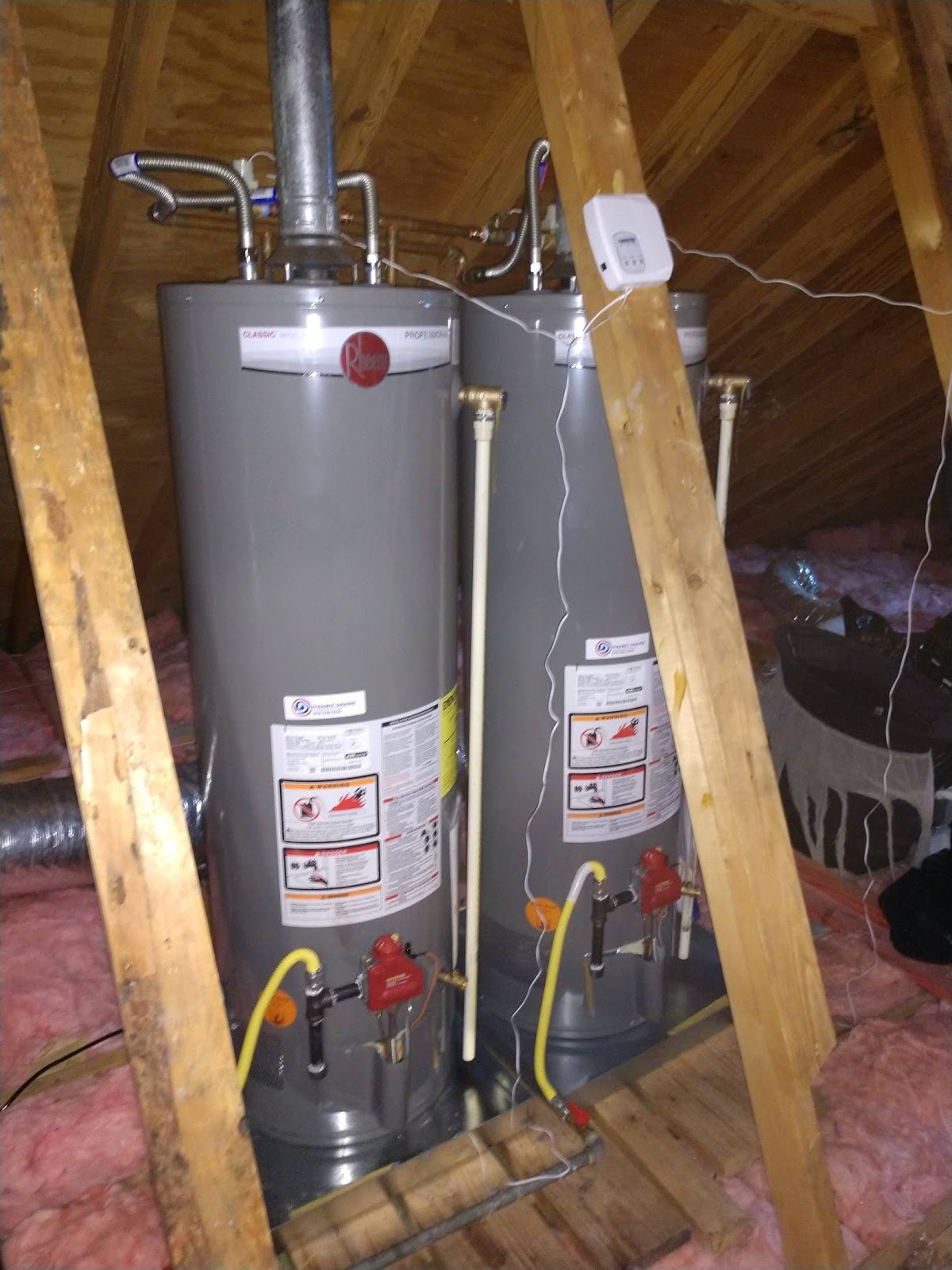
A common residential water heater in an attic with Flood Stop valves installed that will automatically shut off the water in the event of a leak.
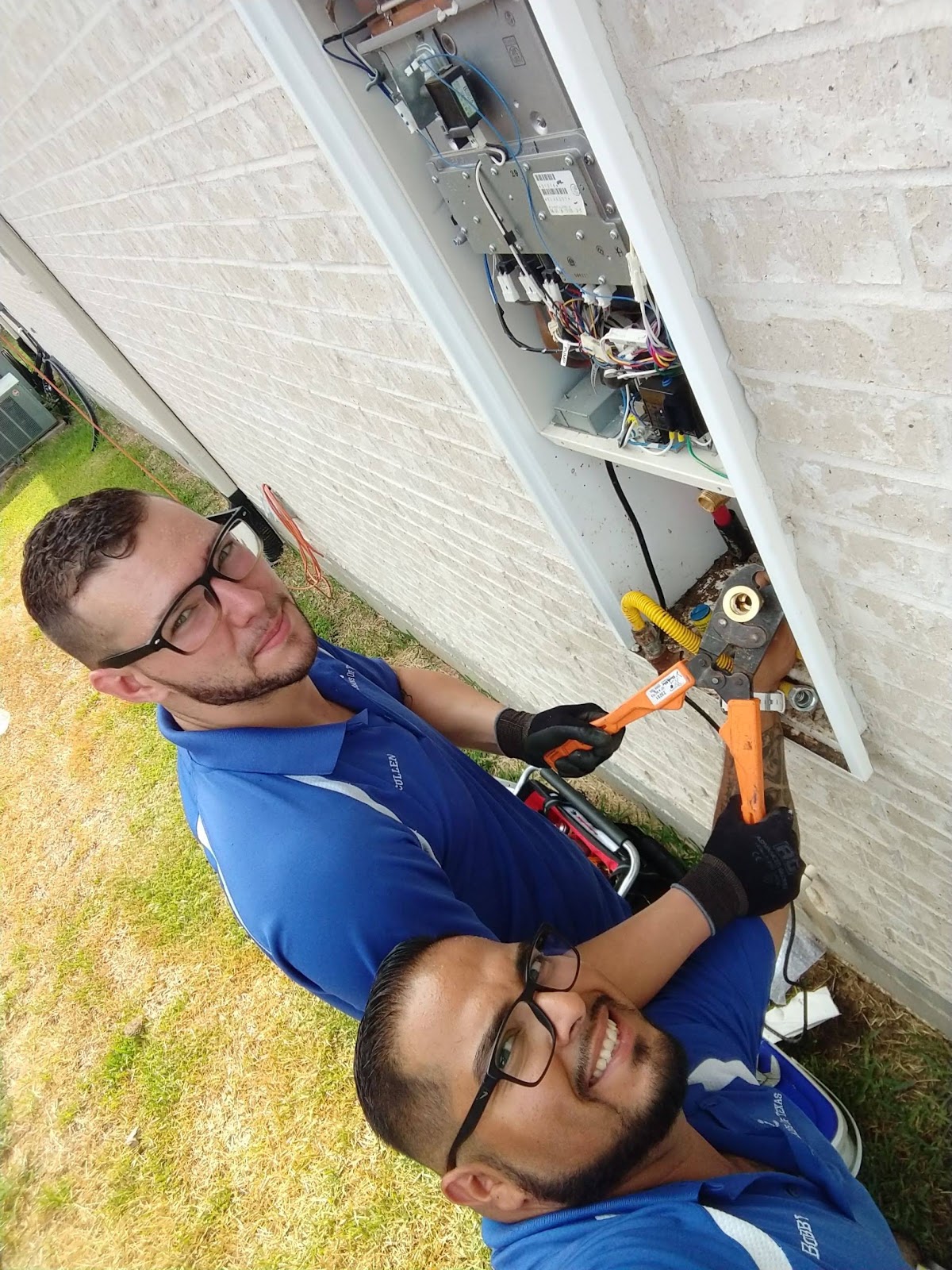
A tankless water heater being serviced by Bobby and Cullen that was installed during construction on an outside wall and recessed inside a box being serviced.
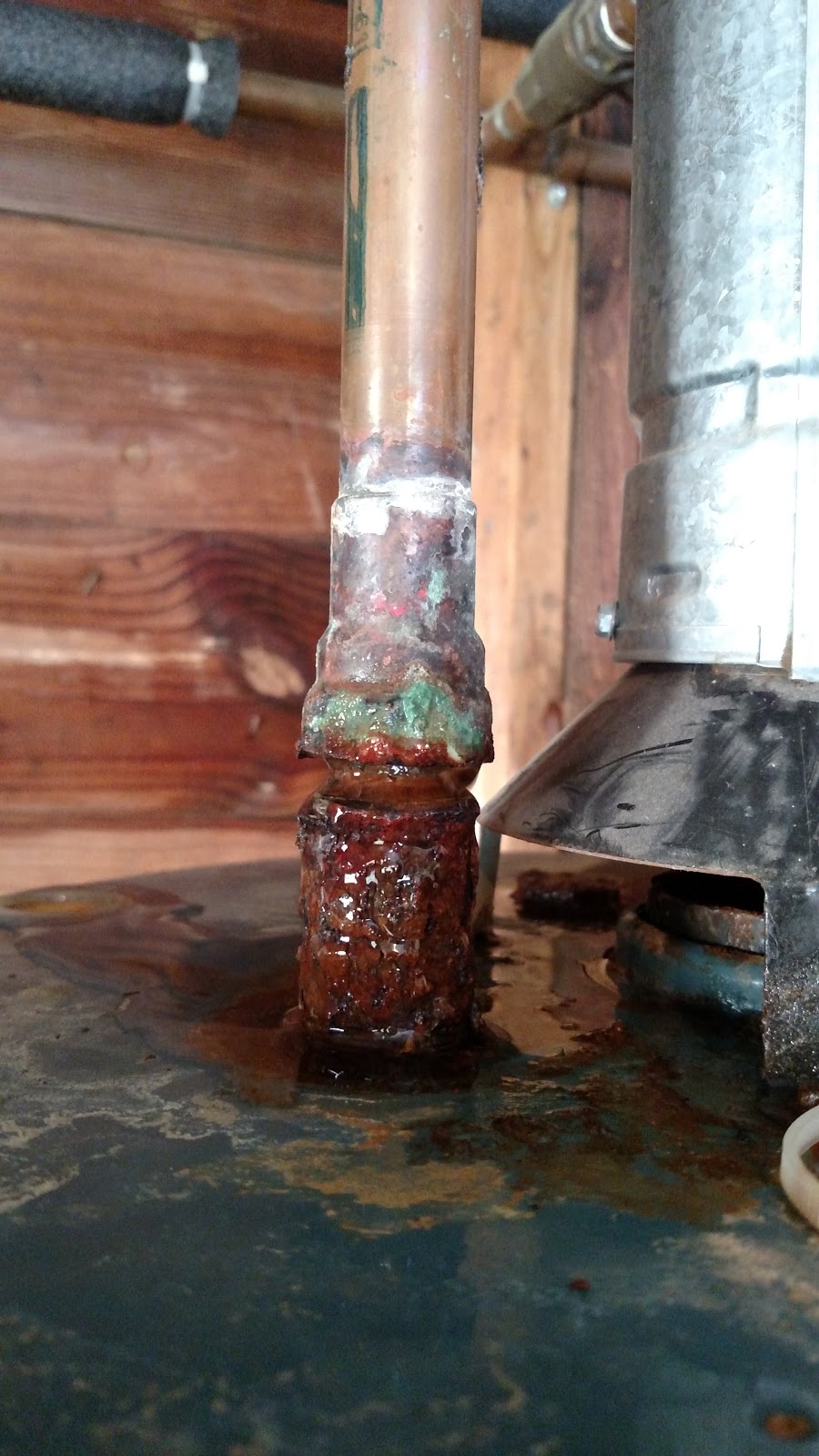
A common sight for a service plumber: a leaking water heater that has been slowly leaking for some time but went unnoticed by the owner.
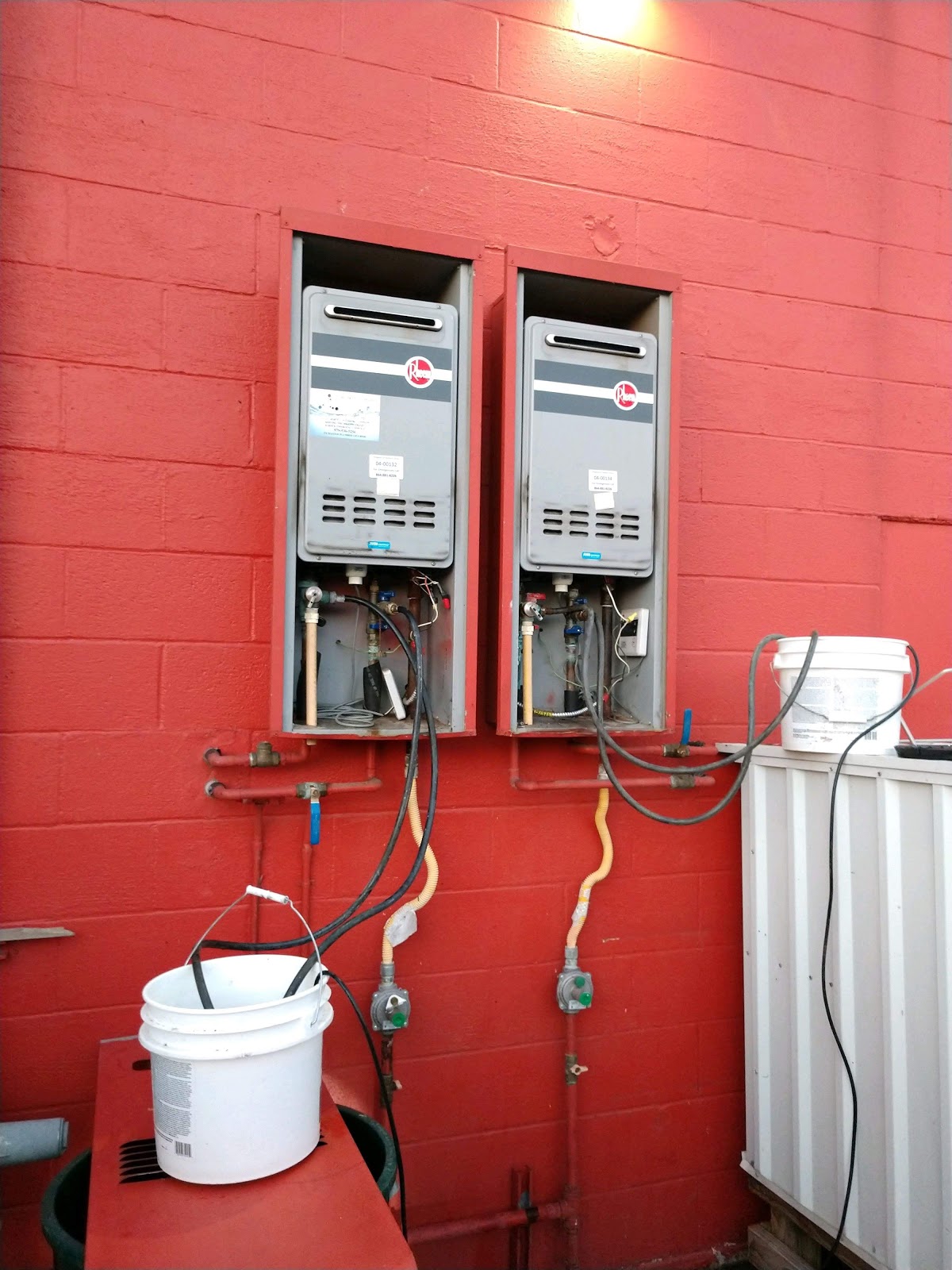
Two tankless water heaters installed outside recessed in boxes for a restaurant. This photo was taken while we were descaling them.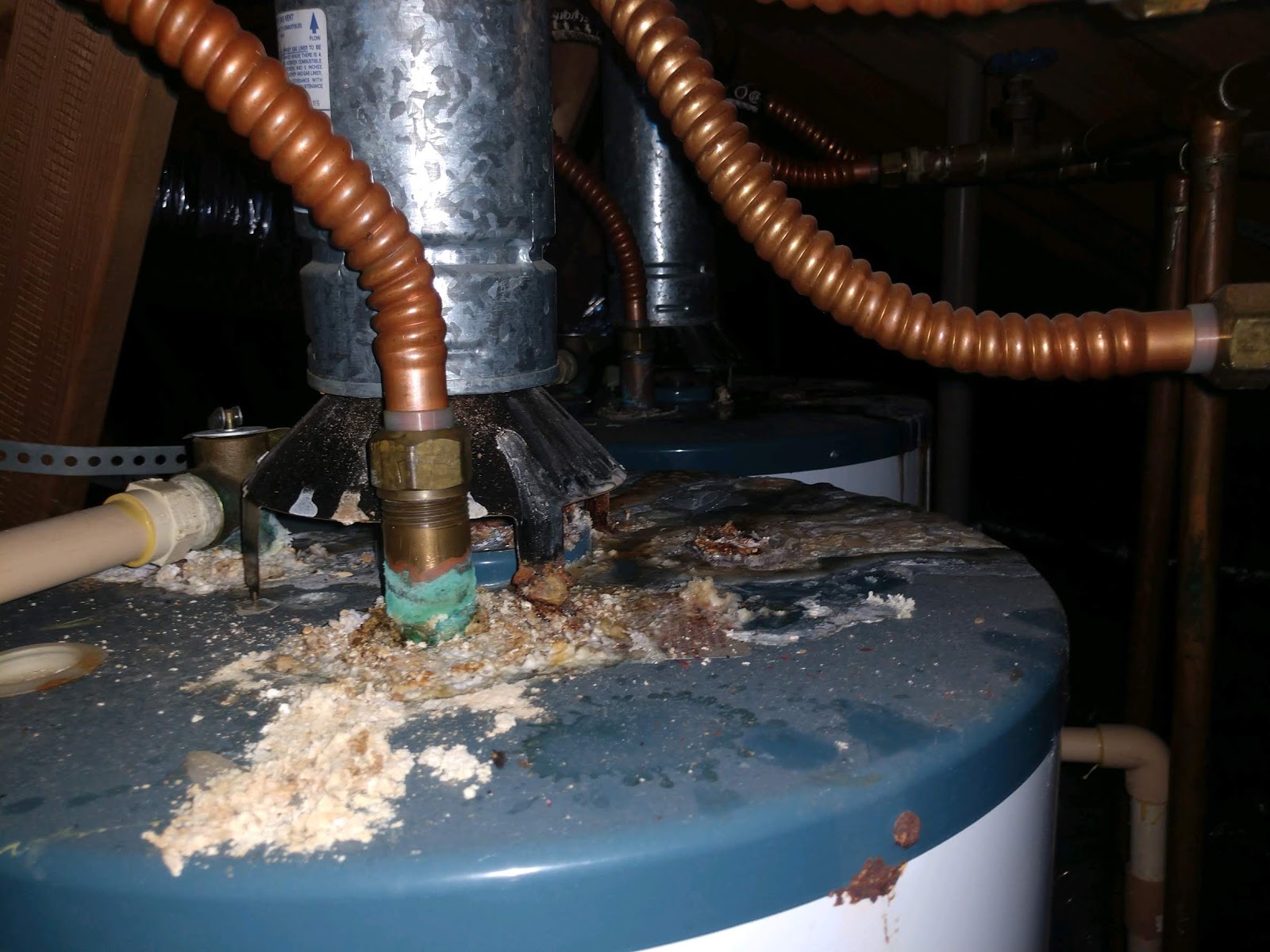 Another water heater with a lot of corrosion that was located in an attic. This water heater had been leaking for a long time but due to it being located inside an attic, it went unnoticed.
Another water heater with a lot of corrosion that was located in an attic. This water heater had been leaking for a long time but due to it being located inside an attic, it went unnoticed.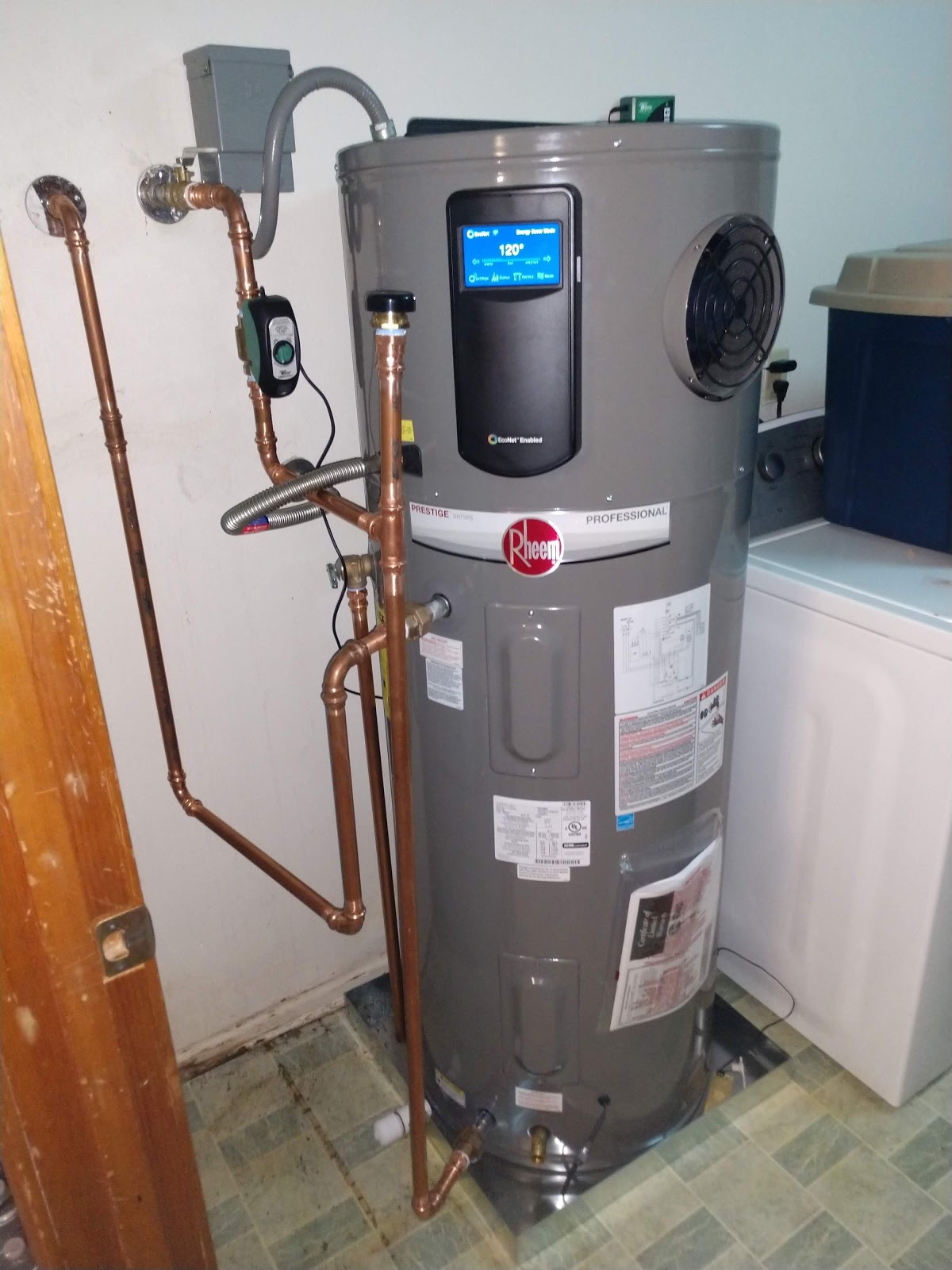
A Rheem Hybrid water heater installed in a utility room. The condensation drain was on the back side and not in the picture.
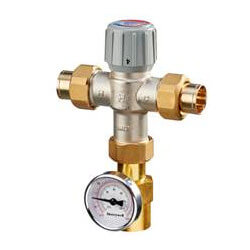
A common tempering valve with thermometer gauge.
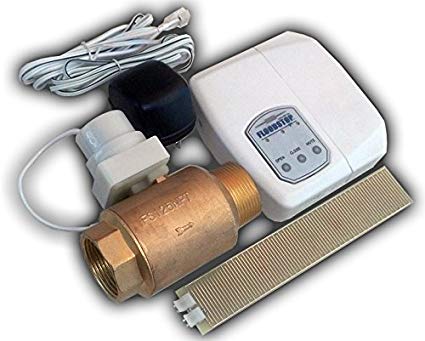
Flood Stop Safety Valve
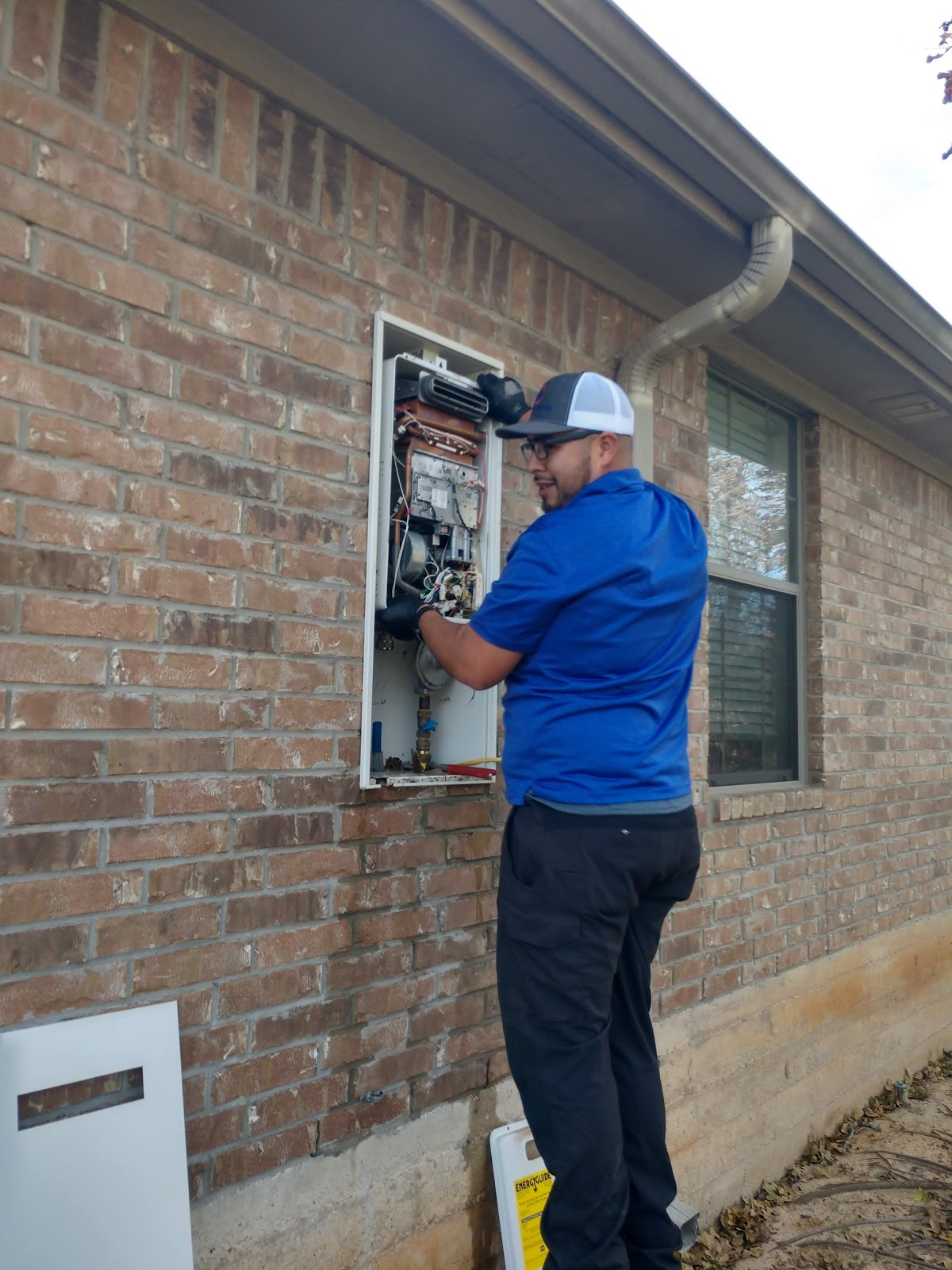
Another outside tankless unit being serviced.
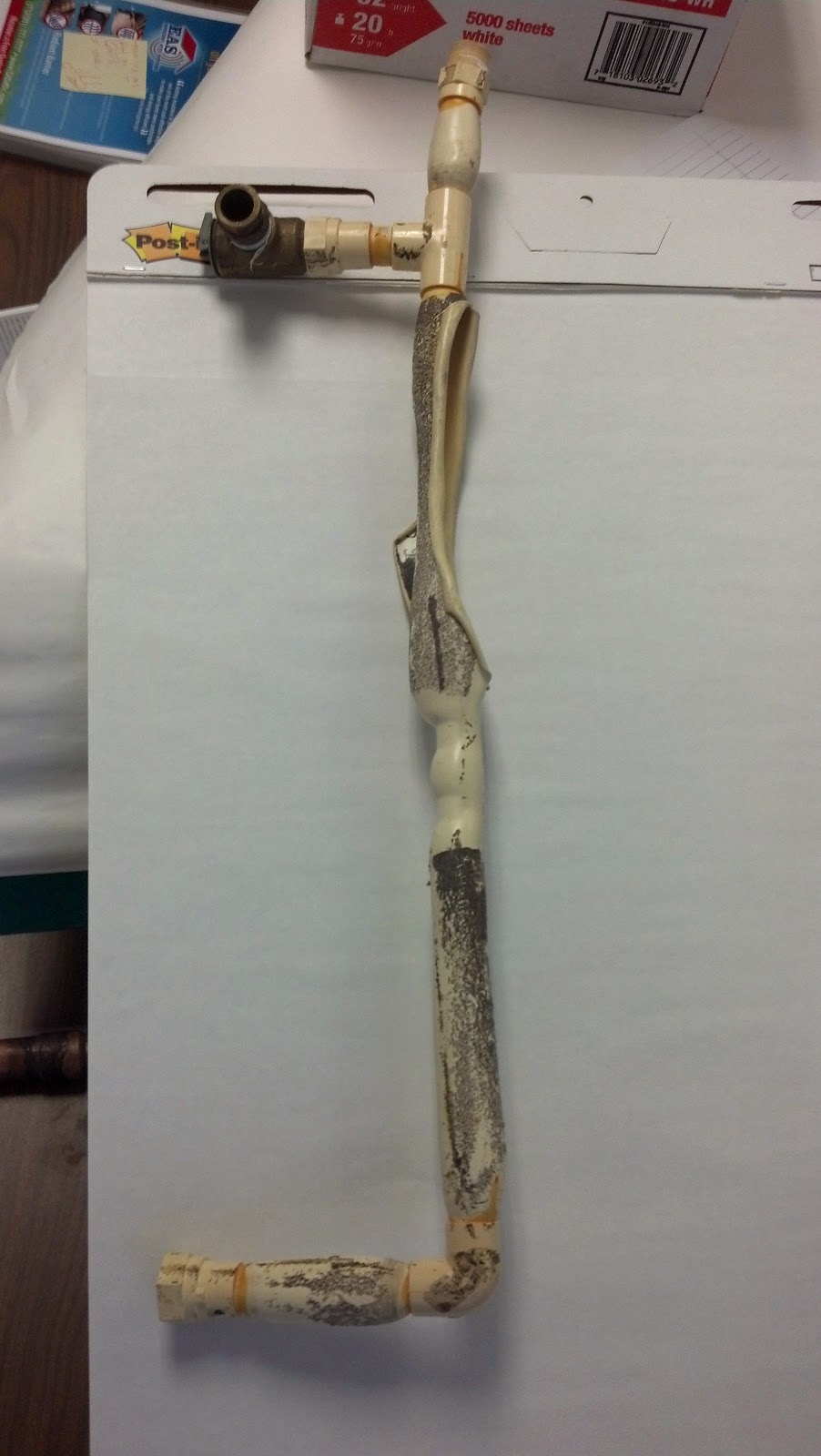
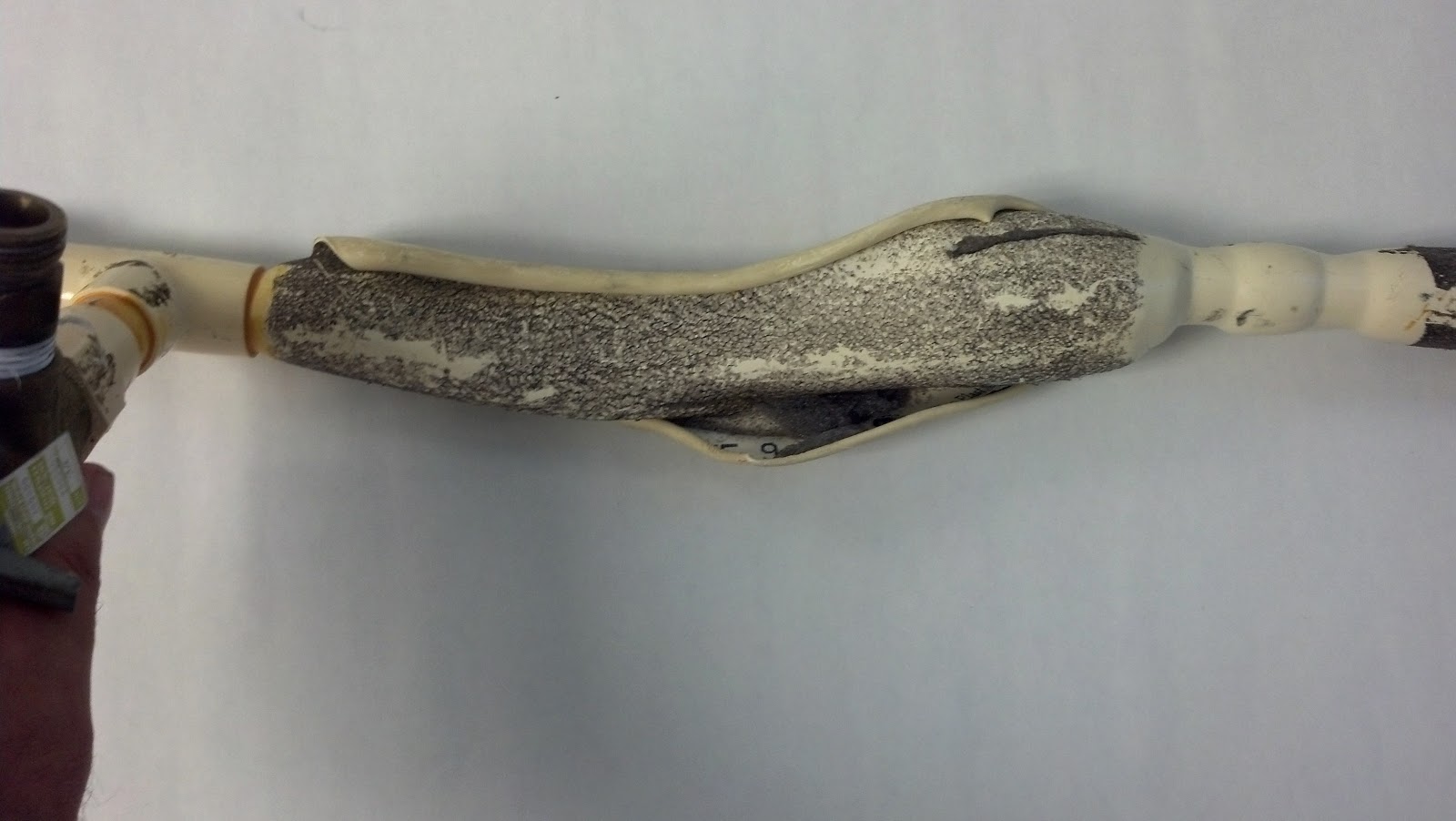
A malfunctioning tankless water heater caused this CPVC plastic pipe to melt and flooded the property.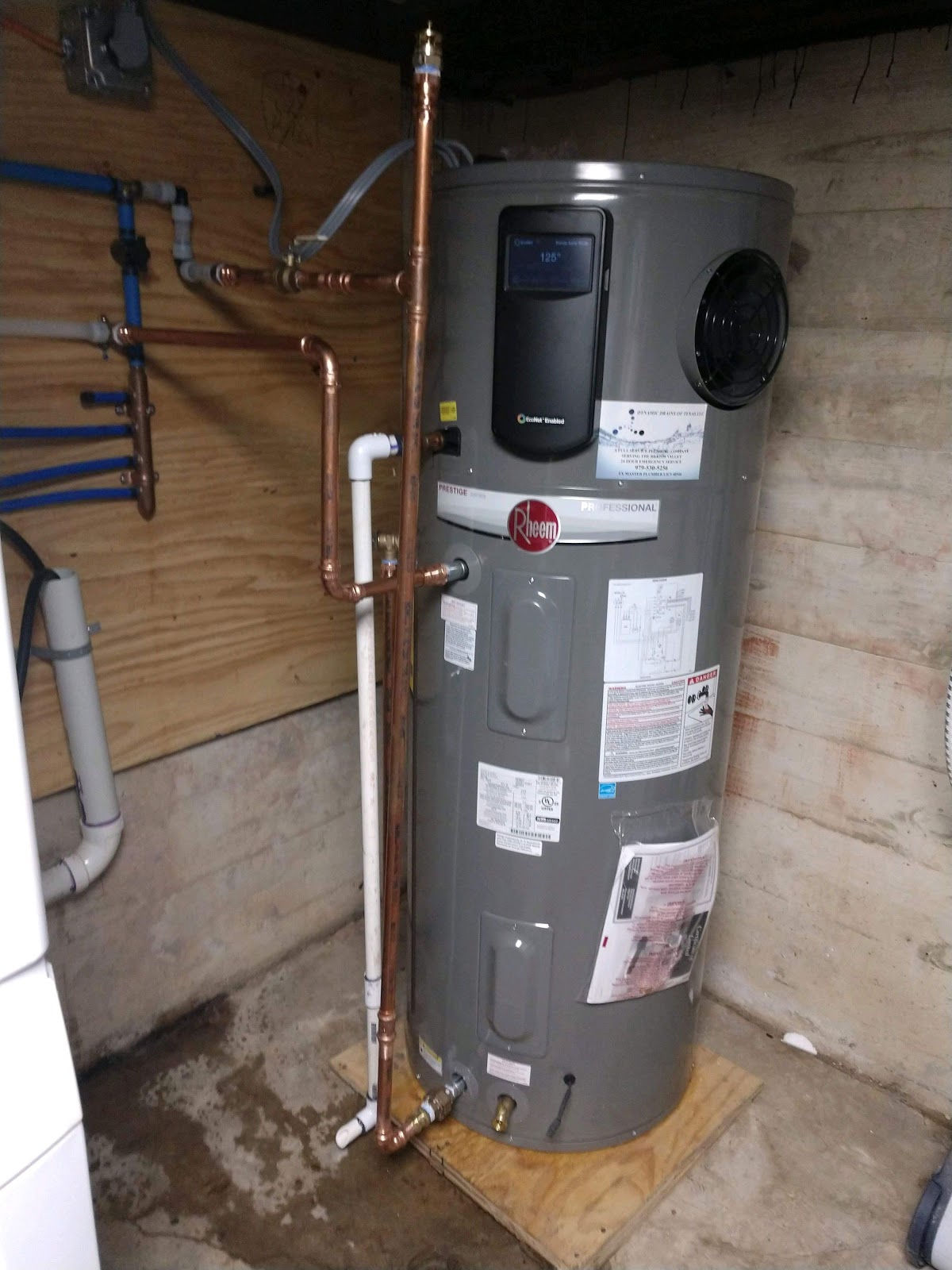 A Rheem Hybrid water heater installed inside a garage.
A Rheem Hybrid water heater installed inside a garage.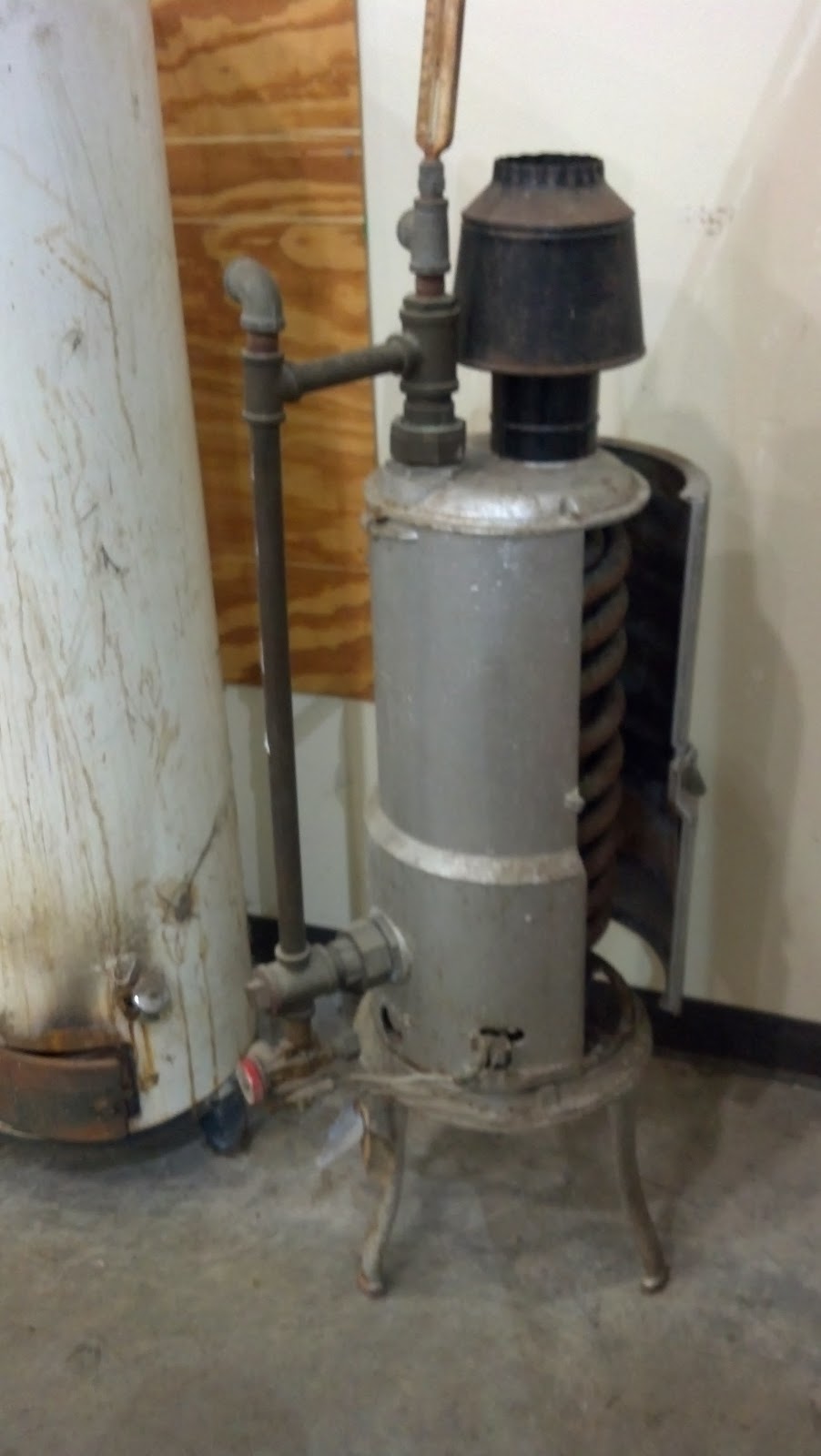
A very old tankless water heater.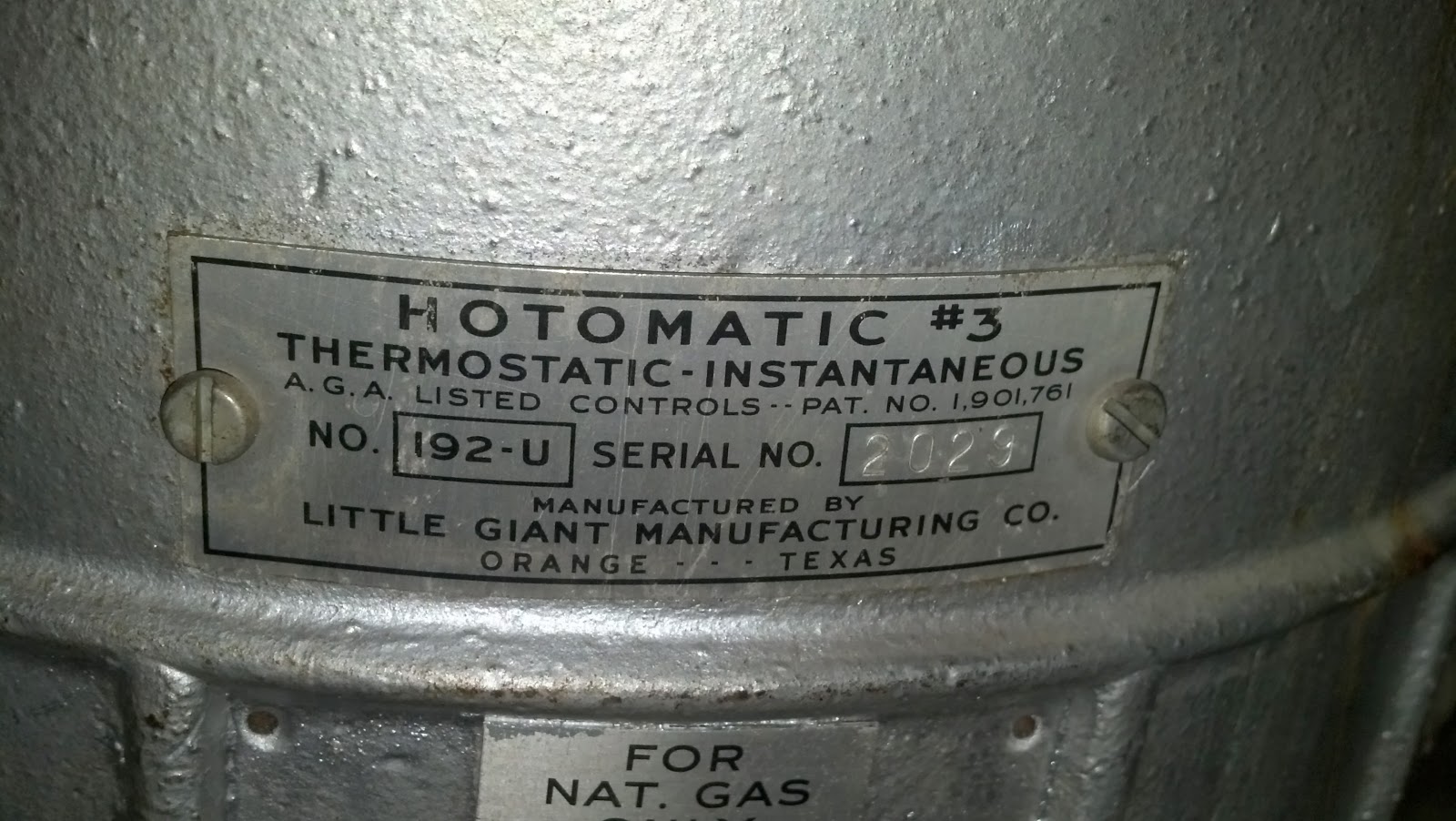
The model and serial number for that old tankless water heater.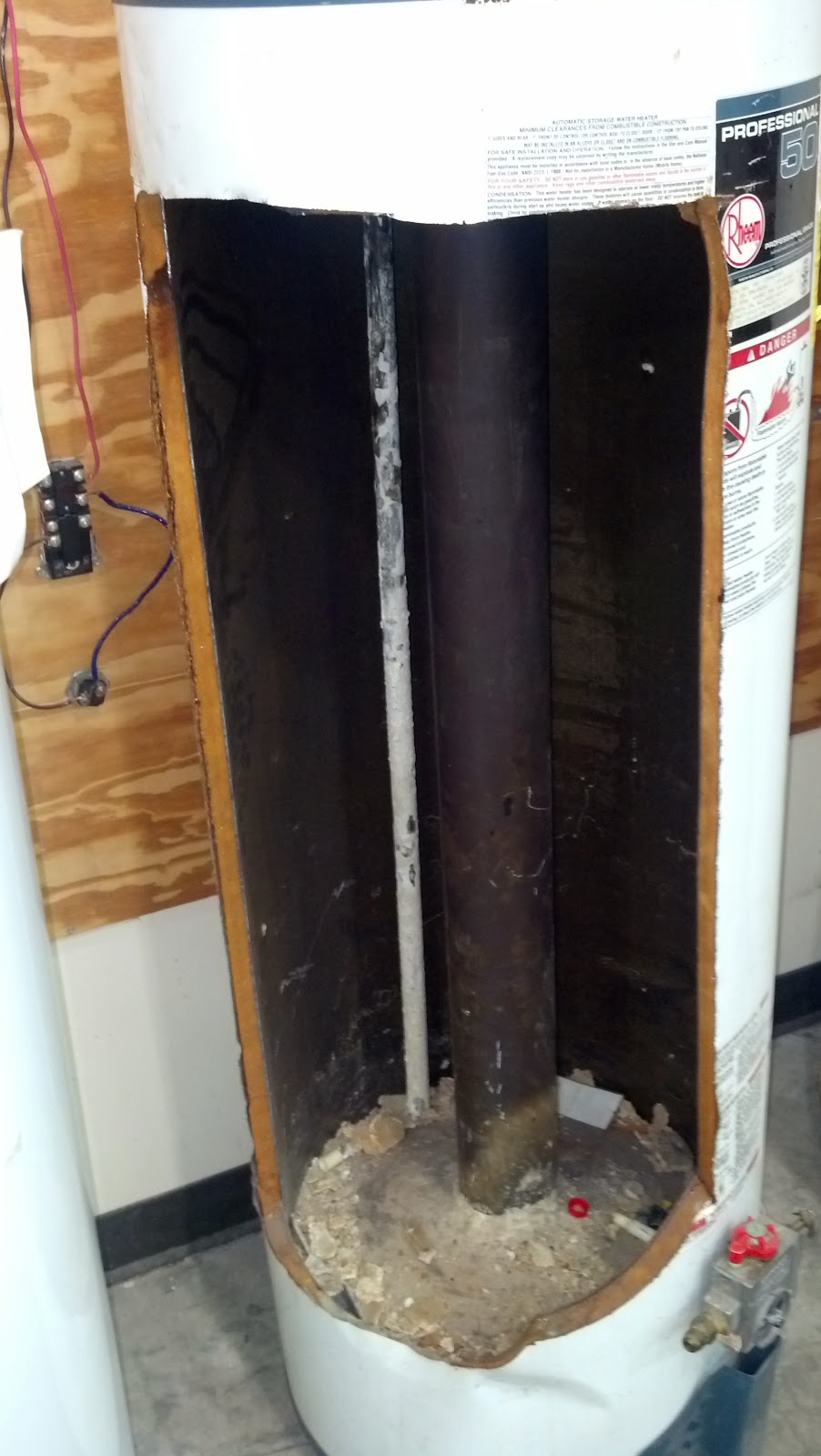 A gas water heater with the front cut out to expose the insulation and what the inside looks like. The yellow stuff on the walls is the insulation around the tank enclosed within the jacket.
A gas water heater with the front cut out to expose the insulation and what the inside looks like. The yellow stuff on the walls is the insulation around the tank enclosed within the jacket.